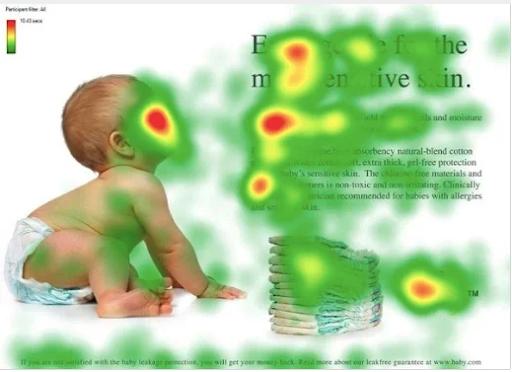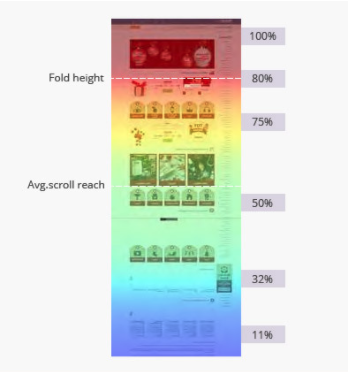Heatmaps have been a mainstay of the digital marketing scene for a while now.
They’re an essential tool for helping marketers understand how users interact with a website.
Use them to learn what kinds of images best capture your audience’s attention or if they’re having trouble navigating your website.
In this post, you’ll learn some ways y0u can use heatmaps to improve your SEO strategy.
So, What Is a Heatmap?
Heatmaps are data visualization tools designed to help website owners understand how well a specific page is performing.
The idea is to make it easy for users to visualize complex data sets by representing values with color.
Heatmaps measure user behavior on a scale from red to blue, with the warmest color indicating the highest level of engagement and the coolest indicating those areas with the lowest engagement levels.
Now, it’s also worth noting that there are a few different types of heatmaps you can use to measure webpage activity.
Here’s a brief overview of some of the more common examples:
- Scroll maps: Track how far readers made it down the page before dropping off. The redder the area, the more people read it.
- Click maps: Track where users click most often. This could be internal links, the navigation bar, logos, images, CTA buttons, and anything that appears to be clickable.
- Hover maps: Track where users move the cursor around the page. Hot spots are indicated by where users pause most often.
Now that we’ve covered some basic heatmap info, let’s move on to some ways that you might use heatmaps to take your SEO strategy to the next level.
1. Learn More About User Intent
Visual analytics offers a unique opportunity to learn more about audience behavior.
Another thing you can do with heatmaps is to figure out which parts of the page get the most play.
Which content do people care about, and which sections do they scroll over without stopping?
At which point do users drop off?
Additionally, you might try looking at which menu options and filters get the most play – which can tell you which topics your audience cares about most.
This data can then be used to inform your PPC campaigns, as well as future landing pages and blog posts.
Compare heatmap data to paid search data to uncover keyword opportunities you can use to inform your content strategy, ad copy, social posts, and so on.
It might also be worth checking Google Analytics for bounce rates and dwell times.
Here, your goal is to find out how many people visit the page, then leave because there’s something missing or the content isn’t relevant.
2. Optimize Page Layout
In many cases, page structure is something we try to navigate by applying our best judgment.
Sure, the importance of things like H2s, H3s, and white space have been drilled into our minds.
However, there are literally hundreds of factors that contribute to great user experience.
The most common way to use heatmaps is for gaining an understanding of how customers interact with on-page elements like CTA buttons, where friction exists, and visitors move through the site.
For example, in this side-by-side, the image on the left revealed that visitors spent more time looking at the promotional banner, which advertised a rewards program, than completing the checkout.
The image on the right addresses the problem by making subtle changes that more effectively guide users toward the desired action.

You might also use heatmaps to optimize image placement to increase conversions.
For example, here are two versions of an ecommerce landing page.
In the first version, the baby is looking directly at the viewer, making the face the strongest element on the page.

In the second version, we have the baby looking toward the web copy, ensuring that visitors pay attention to the messaging and offer.

3. Use Heatmaps with Analytics to Uncover the ‘Why’ Behind Your Metrics
Analytics platforms like Google Analytics allow you to collect tons of quantitative data.
You can track page views, referral traffic, bounces, and how many times someone abandoned a cart.
The problem is, those insights don’t offer much in the way of “why” consumers take those actions.
For example, if your heatmap reveals that a ton of people click a certain button, but don’t convert, head over to your GA account to sort things out.
Navigate to Behavior > Site Content > All Pages, and then click Destination URL.
From there, you might use a heatmap to understand how users interact with the destination page.
For example, you notice that most clicks are happening at the bottom of the page.
In this case, that could indicate that the information people are looking for is way too far below the fold.
From there, you might try moving that content further up the page, and test to see whether that change had any impact on conversions.
4. Combine Heatmaps with On-Page Surveys
Heatmaps allow you to identify points of friction, design issues, and other opportunities that your audience might not bring up in a survey or review.
Collecting feedback from multiple sources allows you to paint a clearer picture of users’ relationship with your website.
Try using heatmaps to uncover design issues on specific pages, then use on-site surveys to ask visitors to share their feedback about that page.
- What might they add or change?
- How was their experience?
Keep in mind, you’ll want to make sure that you approach this strategy one issue at a time, otherwise, it’ll be too difficult to analyze your data and implement the recommended changes.
5. Determine Optimal Content-Length
However, Google has long insisted that word count does not equate with quality content.
You want to focus on giving users the answers they want, not simply taking up more space.
How well does each page match your audience’s search queries?
You can use heatmaps to uncover how much information your customers want on any given topic.
Use a scroll map to find out where users are dropping off the page.

Have you answered a question up top and there’s no need for readers to keep scrolling on?
Or, are readers scanning for information then dropping off after realizing you aren’t going to provide the information they were hoping for?
While the heatmap itself won’t provide the full answer here, you should start by finding out where people are dropping off, then look at what they do next.
- Are they leaving your site for good or have they found what they need and are moving on to the purchasing phase?
- What do your competitors cover on similar pages?
- What can you do to create something better?
6. Improve Your Internal Linking Strategy
Internal links are essential for helping the Googlebot understand the structure of your website.
From Google’s perspective, the anchor text you use to link to different parts of your website provides more context for what that target page is all about.
Additionally, internal linking allows you to distribute link equity between pages and establish a content hierarchy where the most important pages are given the highest value.
For organizations that haven’t given internal links much thought, making an effort to improve the connections between pages can be a quick way to boost your rankings.
For marketers relying on content to grow their site, internal linking offers an opportunity to strengthen authority around key topics, grouping content into “cornerstone” or “pillar” pages and subtopics.
So, how can heatmaps help with this?
The benefit of using heatmaps to measure internal link performance is, they offer specific information about where users click.
Users can take those insights to optimize link placement, driving more traffic to related pages.
7. Structure Your Site Around the Buying Process
Done right, your website should be set up in a way that guides users to relevant content that aligns with their stage in the customer journey.
This means you’ll need to make sure that all of your links work together to nurture your visitors and offer them valuable insights, so they stay with you from awareness to purchase and beyond.
To ensure that people are clicking on the “right” content, clickmaps to learn which links users click.
Clicking links takes users away from the page they’re currently reading, so you’ll want to find out whether the links embedded in your articles are relevant.
If they’re irrelevant – or jump to a completely different place in the buyer’s journey, you risk driving those users away from your website altogether.
As you evaluate each page, look at what happens after the user clicks an internal link.
Ask yourself the following questions to determine relevance:
- How much time do they spend on the new page?
- How far do they scroll?
- Do they continue exploring your content?
- Does the session end with the user taking action?
8. Identify Confusing Elements Causing Friction
Another advantage of using heatmaps is they provide website owners with specific information about which elements that users find confusing.
Have you ever visited a website where items looked clickable but didn’t help you get to the next page?
It’s annoying, right?
Well, your customers feel the same way.
Items that appear “clickable” might not seem like that big of a deal, but they indicate that a page’s structure fails to meet expectations.
Clickmaps can help you spot the areas where customers expect to find links, allowing you to go back and add them in to meet your audience’s expectations.
In addition to unclickable items, heatmaps can help you identify other signs that users “aren’t getting it.”
Think hovering for a long time in weird places or a high number of drop-offs on a certain page.
Make a list of all of the weak spots you encounter on each page, and as you improve each area, see if bounce rates and conversions improve.
Ultimately, you want to make sure that you look out for any issues preventing your audience from converting – whether that’s a poor checkout experience, images that look like buttons, or convoluted copy.
9. Improve Your Outbound Linking Strategy
It may seem counterintuitive, but including outbound links within your content is good for SEO.
While some site owners worry that following this bit of advice will drive users away, the fact is, referencing reputable sources shows readers (and search engines) that you care about providing useful information – regardless of where it comes from.
The links you include in your web copy can play a major role in how your audience perceives your content, according to research from Stanford University.
Link to spammy sites and your credibility goes out the window.
So, where do heatmaps come into play?
There are actually a couple of different ways.
For one, you might try using a click map to uncover which links get the most clicks.
This will help you figure out which links your audience is most interested in – which websites/institutions do they perceive as being most credible/interesting?
Second, you might also use a scroll map to analyze your content.
For example, you might find that readers drop off after encountering an outbound link they perceive as spammy or irrelevant.
If that’s the case, link out a better source, then see if things improve.
If not, then it’s worth looking into how you can make the rest of the piece more engaging.
Wrapping Up
Understanding how your visitors interact with your site’s content, structure, and on-page elements allows you to build a strategy that gets users to stick around, read a blog, and ultimately, convert more often.
Heatmaps serve as an ideal starting point, allowing marketers to identify big-picture problems that cause friction and new opportunities to drive traffic and conversions.
That said, you shouldn’t rely exclusively on heatmaps for research.
They’re one of many tools that come together to shape your understanding of the buyer’s experience.
More Resources:
- Elevating Your Analytics: A Guide for SEO Beginners
- Why Google Search Console & Google Analytics Data Never Matches
- 10 Great Google Analytics Alternatives
Image Credits
In-Post Image #1: Convince and Convert
In-Post Image #2: VWO
In-Post Image #3: UXmag





